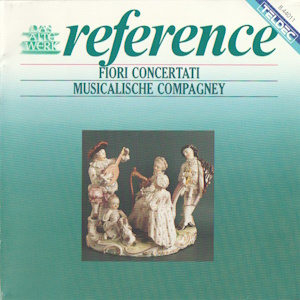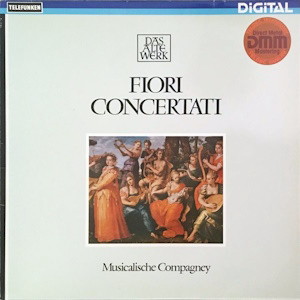 |
| 1 CD -
8.44011 ZS - (C) 1988 |
 |
| 1 LP -
6.42851 AZ - (p) 1983 |
|
FIORI CONCERTATI
|
|
|
|
|
|
|
|
|
|
| Dario CASTELLO
(16./17. Jh.) |
Sonata Nona à 3
für Cornetto, Violine, Dulcian,
Chitarrone und Orgel
|
|
8' 05" |
1 |
A1
|
|
Sonata Seconda à
Sopran Solo für Violine,
Chitarrone und Orgel |
|
5' 44" |
2 |
A2
|
|
Sonata Ottava à 2
für Cornetto, Dulcian und Orgel |
|
5' 15" |
3 |
A3
|
|
Sonata
Decima à 3 für Violine,
Cornetto, Dulcian, Chitarrone und
Orgel |
|
5' 25" |
4 |
A4
|
| Andrea FALCONIERI
(1586-1656) |
Battaglia de
Barbaso yerno de Satanas für
Conetto, Violine, Dulcian,
Chitarrone und Orgel |
|
4' 18" |
5 |
B1
|
|
Passàcalle à 3
für Cornetto, Violine, Dulcian,
Chitarrone und Orgel |
|
3' 37" |
6 |
B2
|
| J.
H. KAPSBERGER (um 1575-1661) |
Toccata &
Ballo für Chitarrone und Orgel |
|
5' 50" |
7 |
B3
|
| Andrea
FALCONIERI |
Folias
echa para mi Señora Doña Tarolilla
de Carallenos à 3 |
|
4' 10" |
8 |
B4 |
|
für Cornetto, Violine, Dulcian,
Chitarrone und Orgel |
|
|
|
|
|
Sinfonia
· Gallarda · La Xaueria Buelta
echa para el Señor Conde Xauerio ·
La Carilla Corrente à 3 |
|
7' 12" |
9 |
B5 |
|
für
Cornetto, Violine, Dilcian,
Chitarrone und Orgel
|
|
|
|
|
|
|
|
|
|
| MUSICALISCHE
COMPAGNEY |
The Instruments
|
|
- Holger Eichhorn, Zink
(Cornetto)
|
Cornetto:
Rainer Weber, 1973 |
|
| - Thomas Albert, Violine |
Violine:
Jacobus Stainer, 1680 |
|
| - Bernhard Junghändel,
Dulcian |
Dulcian:
Bernhard Junghändel, 1974 |
|
| - Stephen Stubbs, Chitarrone |
Chitarrone:
Jacob van der Geest, 1975 |
|
| - Klaus Eichhorn, Orgel |
Orgel:
Anonymus, neapolitanisch, 17. Jh. |
|
|
|
|
|
Luogo
e data di registrazione |
|
- |
|
|
Registrazione:
live / studio |
|
studio |
|
|
Producer /
Engineer |
|
- |
|
|
Prima Edizione
LP |
|
Telefunken
- 6.42851 AZ - (1 LP) - LC 0366 -
durata 50' 36" - (p) 1983 -
Digital |
|
|
Edizione
"Reference" CD
|
|
Tedec
- 8.44011 ZS - (1 CD) - LC 3706 -
durata 50' 36" - (c) 1988 - DDD |
|
|
Cover |
|
"Die
spanischen Musikanten", Porzellan.
Modell von C. G. Lück, Frankenthal
vor 1770. Museum für Kunst und
Gewerbe, Hamburg.
|
|
|
|
|
The first
decades of the 17th
century saw an
increasing output in
Italy of instrumental
music for small esembles
- solos, duets, trios
with continuo. Editions
of this type of music,
which frequently
contained both vocal and
instrumental pieces,
were often adorned with
poetic, indeed florid
titles "Fiori
musicali...", "lilia
sacra---", "giardinetto
di ricreatione...",
"vaga ghirlanda di
soavi, & odorati
fiori usicali...". The
present florilegium of
Italian instrumental
music is composed of the
most usual types of
pieces from the first
half of the Seicento,
both of the well-tried
traditional kind and of
the avant-garde of the
day: dances, ostinato
pieces, programme music,
improvvisations and
concerted sonatas,
Though the Italian art
music reperoire of the
17th century covered a
wide rangt of
instrumental genres,
only a few of these
proved capable of
enduring and developing.
Apart from the Canzona
which was nooted in
tradition, the
improvisatory Toccata
for solo performance,
and the loosely knit
dance suite that was
assuming ever greater
popularity, the Sonata
was the most important
type of early barique
instrumental music. The
structure of this early
type of sonata was
determined mainly by an
increasingly
standardised pattern of
movements: the
alternation of slow -
fast - slow or fugato -
chordal - dance-like
sections of contrasting
moods generally
characterising the
separation between
Church and Chamber
Sonata, which was
completed by the end of
the century. The
extremes of emotion in
this early type of
sonata were the
dance-like and the
highly expressive. The
alternation of sadness
and joy, seriousness and
jollity, urgency and
repose provided the
basic pattern of a
"sonata da chiesa" with
several movements. If
the basic pattern was
enhanced by the contrast
between ensemble
movements and
subsections of a
virtuoso nature, the
resulting work was a
"sonata concertata". In
this kind of work the
double meaning of the
concept "concerto" is
particularly apparent
"agreement" on the one
hand and "competition"
(contentio o contrasto)
on the oter do not have
to be mutually
exclusive, but can
perfectly well "act in
concert". This concerted
element was not,
however, confined to the
sonata but spread to
other types of music.
Dances, and forms
developed from the dance
such as variations and
ostinato structures, e.
g. the Follia and
Passacaglia, were just
as likely to contain
such features as was the
"Battaglia" with its
rich tradition.
One of the most
interesting composers of
"Sonate concertate" was
Dario Castello. There is
a strange imbalance
between his significance
as a composer and the
minute amount of factual
information available
about him. Almost the
sum total of what is
kown about him, some of
that incorrect, is to be
found in J. G. Walther's
Lexikon of 1732.
"Castello (Dario), a
Venetian, a musician at
St. Mark's also Capo di
Compagnia de'
Instrumentisti (his own
description), has
published concerted
sonatas in 1, 2, 3 and 4
parts, the second volume
of which was printed in
folio at Venice in 1627
and dedicated to the
emperor Ferinand II. In
1629 he had another 12
sonatas in 2 and 3 parts
printed, and dedicated
them to the choirmaster
of the day, P. Giacomo
Finetti."
Castello attempted to
translate the emotional
models and ideas of
Monteverdi, Grandi and
others into the language
of the ensemble sonata.
His two collections
"Sonate concertate in
stil moderno" which were
reprinted several times,
contained sonatas for
one or two instruments,
trios and quartets of
all manner of
combinations. Of
particolar interest in
the tremendous variety
of motifs and melodies
and also the wide range
of diflering emotions,
the alternation of which
in only indicated by the
markings "alegro",
"adagio", "presto", and
quite often not at all.
Even his "adagio" hat
several interpretations:
a many samply mean slow
or heavy, as in a
"grave" piece, but is
may also indicate strong
emotion sorrow, quiet,
grief, excited
accusation, theatening
pathem, restrained
melancholy, sweet
suffering and charming
singing. Castello also
uned rests in all parts
with dramatic effect,
particularly after
presto movements. His
sonatas are arranged
with considerable
variety, with movements
and sections of
movements of widely
differing lenght,
intensity, motion and
texture. Sonata IX, for
example, is composed of
five sections, the first
of which has four
subgroups, the fourth
five, and the fifth
three. The widest range
of rhetorical freedorn
and emotional expression
is to be found in the
violin sonata, which in
full of idiomatic
subtletics and
sentiment.
Although Venice was for
a long time considered
the musical metropolis
of Europe, Rome and
Naples, here represented
by Johannes Hieronymus
Kepsberger and Anbdrea
Falconieri, also became
important musical
centres in Italy. Along
with Frescobaldi and
others, Kapsberger
belonged to the cream of
Roman virtuosi in the
middle of the century. A
German who spent mont of
his life in Rome (from
1610 until his death in
1650), he was a
lutenist, a prolifie
composer and favoured
the then newly invented
chitarrone. In addition
to a large arnount of
vocal music and solo
works for lute and
theorbo, he left behind
a number of pieces for
chitarrone with organ
accompaniment containing
inter alia toccatas and
dances.
Andrea Falconieri was
also a lutenist and
composer. After a great
dead of restless robing,
including a visit to
Spain lasting almost
nine years, he was
appointed director of
music at the Sèamosh
royal court in Naples.
There he published,
inter alia, a collection
of instrumental works in
one, two and three
parts, all of which are
remarkable for their
originality and
freshness. Particularly
striking in their
melodic invention and
his astoishing handling
of dissonances. His
Battaglia takes up a
number of typical motifs
rapid repetitions occur
frequently as a
structural element.
Falconieri was one of
the first composers to
expand ostinato works
into larger designs. In
the Follia and
Passacaglia there are
significant bass
patterns over which
traditional dances et al
were improvised. In this
context, ostinato is to
be understood as
"dirmation vy way of
continuous, striking
repetition of clearly
defined rhythmic or
melodic () or harmonic
() material which
structures the musical
process, functions an a
(variable) constant
which links the strands,
and the melody of which
appears as a
constructive element,
usually in the part
which is structurally
the most important
(tenore, bass) in the
texture; repetition is
linked with variation ()
of the additional
elements and even of the
material of the
repetition itself,,,"
(H, H, Eggebrecht,)
Dances with Spanish
names and dedications
round oft this picture
of an important
collection which
furnishes impressive
èrppf of the high
standanrd attained by
the "Fiori concertati"
in th middle of the
Seicento.
Holger
Eichorn
Translation: Lindsay
Craig
The Musicalische
Compagney, anensemble
devoted to music of the
16th amd 17th centuriesm
was founded in 1972 by
Holger Eichhorn
(cornettist and
musicologist) and Klaus
Eichhorn (church
musician). Taking as a
working title "An
experiment in the real
way to play historic
music", the group
strives to reconcilie a
historically accountable
- i. e. intellectually
appropriate -
presentation of the
correlation of timbre,
delivery and emotional
expression with actual
performance. The
Musicalische Compagney
had cosolidated its
reputation as a rather
special ensemble with
numerous concerts in
Germany and abroad
(Belgium, Denmark, East
Germany, France,
Holland, Italy, Austria,
Switzerland, USA...),
and with radio and
television broadcasts
and gramophone
recordings, Among the
major events in their
work in recent years
have been an hour-long
television film, the
first performance of
Monteverdi's "Vespers"
in the conjectural
original version and an
annual series of
concerts which the group
has now given several
years running.
|
|